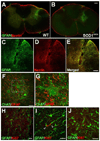Acute glial activation by stab injuries does not lead to overt damage or motor neuron degeneration in the G93A mutant SOD1 rat model of amyotrophic lateral sclerosis
- PMID: 20005223
- PMCID: PMC2839070
- DOI: 10.1016/j.expneurol.2009.12.004
Acute glial activation by stab injuries does not lead to overt damage or motor neuron degeneration in the G93A mutant SOD1 rat model of amyotrophic lateral sclerosis
Abstract
Amyotrophic lateral sclerosis (ALS) is a neurodegenerative disease where motor neurons within the brain and spinal cord are lost, leading to paralysis and death. Recently, a correlation between head trauma and the incidence of ALS has been reported. Furthermore, new invasive neurosurgical studies are being planned which involve inserting needles directly to the spinal cord. We therefore tested whether acute trauma to the spinal cord via a knife wound injury would lead to accelerated disease progression in rodent models of ALS (SOD1(G93A) rats). A longitudinal stab injury using a small knife was performed within the lumbar spinal cord region of presymptomatic SOD1(G93A) rats. Host glial activation was detected in the lumbar area surrounding a micro-knife lesion at 2 weeks after surgery in both wild type and SOD1(G93A) animals. However, there was no sign of motor neuron loss in the injured spinal cord of any animal and normal motor function was maintained in the ipsilateral limb. These results indicate that motor neurons in presymptomatic G93A animals are not affected by an invasive puncture wound injury involving reactive astrocytes. Furthermore, acute trauma alone does not accelerate disease onset or progression in this ALS model which is important for future strategies of gene and cell therapies directly targeting the spinal cord of ALS patients.
Copyright 2009 Elsevier Inc. All rights reserved.
Figures






References
-
- Alexander JK, Popovich PG. Neuroinflammation in spinal cord injury: therapeutic targets for neuroprotection and regeneration. Prog.Brain Res. 2009;175:125–137. - PubMed
-
- Andersen PM, Sims KB, Xin WW, Kiely R, O'Neill G, Ravits J, Pioro E, Harati Y, Brower RD, Levine JS, Heinicke HU, Seltzer W, Boss M, Brown RH., Jr Sixteen novel mutations in the Cu/Zn superoxide dismutase gene in amyotrophic lateral sclerosis: a decade of discoveries, defects and disputes. Amyotroph.Lateral.Scler. Other Motor Neuron Disord. 2003;4:62–73. - PubMed
-
- Azzouz M. Gene Therapy for ALS: progress and prospects. Biochim.Biophys.Acta. 2006;1762:1122–1127. - PubMed
-
- Barbeito LH, Pehar M, Cassina P, Vargas MR, Peluffo H, Viera L, Estevez AG, Beckman JS. A role for astrocytes in motor neuron loss in amyotrophic lateral sclerosis. Brain Res.Brain Res.Rev. 2004;47:263–274. - PubMed
Publication types
MeSH terms
Substances
Grants and funding
LinkOut - more resources
Full Text Sources
Medical
Miscellaneous

